Wisconsin
Institutions reported making 40% of the more than 3,300 Native American remains taken from Wisconsin available for return to tribes under NAGPRA.
There are 18 institutions located in Wisconsin that reported Native American remains taken from across the country.
| Institution | Remains Not Made Available for Return | Remains Made Available for Return | % of Remains Made Available for Return |
|---|---|---|---|
| Milwaukee Public Museum | 1,557 | 116 | 7% |
| Wisconsin Historical Society | 227 | 804 | 78% |
| Beloit College, Logan Museum of Anthropology | 147 | 224 | 60% |
| University of Wisconsin, Oshkosh | 130 | 55 | 30% |
| Oshkosh Public Museum | 74 | 5 | 6% |
| Lawrence University, Department of Anthropology | 62 | 0 | 0% |
| Neville Public Museum | 55 | 53 | 49% |
| University of Wisconsin, La Crosse | 49 | 0 | 0% |
| U.S. Department of the Interior | 9 | 0 | 0% |
| University of Wisconsin, Madison, Department of Anthropology | 7 | 166 | 96% |
| Kenosha Public Museum | 6 | 0 | 0% |
| University of Wisconsin, Milwaukee, Department of Anthropology | 3 | 85 | 97% |
| Washington County Historical Society | 2 | 0 | 0% |
| John Michael Kohler Arts Center | 0 | 2 | 100% |
| Outagamie County Historical Society | 0 | 3 | 100% |
| Rhinelander High School | 0 | 1 | 100% |
| Sheboygan County Historical Museum | 0 | 6 | 100% |
| University of Wisconsin, Stevens Point | 0 | 2 | 100% |
There are 34 institutions that reported Native American remains taken from Wisconsin.
| Institution | Remains Not Made Available for Return | Remains Made Available for Return | % of Remains Made Available for Return |
|---|---|---|---|
| Milwaukee Public Museum | 1,466 | 9 | 1% |
| Wisconsin Historical Society | 168 | 799 | 83% |
| University of Wisconsin, Oshkosh | 130 | 55 | 30% |
| Oshkosh Public Museum | 56 | 2 | 3% |
| University of Wisconsin, La Crosse | 49 | 0 | 0% |
| Harvard University | 46 | 0 | 0% |
| Neville Public Museum | 27 | 52 | 66% |
| Lawrence University, Department of Anthropology | 22 | 0 | 0% |
| U.S. Department of the Interior | 12 | 26 | 68% |
| Kenosha Public Museum | 5 | 0 | 0% |
| University of Pennsylvania Museum of Archaeology and Anthropology | 5 | 6 | 55% |
| Northwestern Univ., Dept. of Anthropology | 3 | 0 | 0% |
| U.S. Department of Defense | 3 | 0 | 0% |
| University of Wisconsin, Milwaukee, Department of Anthropology | 3 | 61 | 95% |
| Washington County Historical Society | 2 | 0 | 0% |
| Dayton Museum of Natural History | 1 | 0 | 0% |
| Illinois State Museum | 1 | 0 | 0% |
| Mutter Museum, College of Physicians of Philadelphia | 1 | 0 | 0% |
| University of Michigan Museum of Anthropology | 1 | 0 | 0% |
| University of Tennessee, Knoxville | 1 | 0 | 0% |
| University of Wisconsin, Madison, Department of Anthropology | 1 | 166 | 99% |
| Beloit College, Logan Museum of Anthropology | 0 | 106 | 100% |
| Berkshire Museum | 0 | 1 | 100% |
| Field Museum | 0 | 21 | 100% |
| Grand Rapids Public Museum | 0 | 5 | 100% |
| John Michael Kohler Arts Center | 0 | 2 | 100% |
| Outagamie County Historical Society | 0 | 3 | 100% |
| Rhinelander High School | 0 | 1 | 100% |
| S'edav Va'aki Museum | 0 | 1 | 100% |
| Science Museum of Minnesota | 0 | 4 | 100% |
| Sheboygan County Historical Museum | 0 | 6 | 100% |
| University of Colorado Museum | 0 | 1 | 100% |
| University of Iowa, Office of the State Archaeologist | 0 | 6 | 100% |
| University of Wisconsin, Stevens Point | 0 | 2 | 100% |
Institutions made Native American remains taken from Wisconsin available for return to 75 tribes.
| Tribe | Remains Made Available for Return to Tribe |
|---|---|
| Ho-Chunk Nation of Wisconsin | 902 |
| Winnebago Tribe of Nebraska | 707 |
| Menominee Indian Tribe of Wisconsin | 491 |
| Bad River Band of the Lake Superior Tribe of Chippewa Indians of the Bad River Reservation, Wisconsin | 472 |
| Red Cliff Band of Lake Superior Chippewa Indians of Wisconsin | 472 |
| Lac du Flambeau Band of Lake Superior Chippewa Indians of the Lac du Flambeau Reservation of Wisconsin | 471 |
| Lac Courte Oreilles Band of Lake Superior Chippewa Indians of Wisconsin | 469 |
| Lac Vieux Desert Band of Lake Superior Chippewa Indians of Michigan | 457 |
| St. Croix Chippewa Indians of Wisconsin | 456 |
| Leech Lake Band of the Minnesota Chippewa Tribe, Minnesota | 453 |
| Mille Lacs Band of the Minnesota Chippewa Tribe, Minnesota | 453 |
| Sokaogon Chippewa Community, Wisconsin | 453 |
| White Earth Band of Minnesota Chippewa Tribe, Minnesota | 453 |
| Bay Mills Indian Community, Michigan | 444 |
| Sault Ste. Marie Tribe of Chippewa Indians, Michigan | 444 |
| Saginaw Chippewa Indian Tribe of Michigan | 442 |
| Bois Forte Band (Nett Lake) of the Minnesota Chippewa Tribe, Minnesota | 440 |
| Fond du Lac Band of the Minnesota Chippewa Tribe, Minnesota | 440 |
| Grand Portage Band of the Minnesota Chippewa Tribe, Minnesota | 440 |
| Grand Traverse Band of Ottawa and Chippewa Indians, Michigan | 436 |
| Iowa Tribe of Oklahoma | 436 |
| Minnesota Chippewa Tribe, Minnesota | 436 |
| Keweenaw Bay Indian Community, Michigan | 434 |
| Chippewa Cree Indians of the Rocky Boy's Reservation, Montana | 432 |
| Red Lake Band of Chippewa Indians, Minnesota | 432 |
| Turtle Mountain Band of Chippewa Indians of North Dakota | 432 |
| Forest County Potawatomi Community, Wisconsin | 376 |
| Hannahville Indian Community, Michigan | 352 |
| Nottawaseppi Huron Band of the Potawatomi, Michigan (formerly the Huron Potawatomi, Inc.) | 340 |
| Pokagon Band of Potawatomi Indians, Michigan and Indiana | 340 |
| Match-e-be-nash-she-wish Band of Pottawatomi Indians of Michigan | 337 |
| Citizen Potawatomi Nation, Oklahoma | 331 |
| Prairie Band of Potawatomi Nation | 331 |
| Prairie Island Indian Community in the State of Minnesota | 297 |
| Flandreau Santee Sioux Tribe of South Dakota | 293 |
| Lower Sioux Indian Community in the State of Minnesota | 293 |
| Santee Sioux Nation, Nebraska | 293 |
| Sisseton-Wahpeton Oyate of the Lake Traverse Reservation, South Dakota | 293 |
| Spirit Lake Tribe, North Dakota | 293 |
| Upper Sioux Community, Minnesota | 293 |
| Shakopee Mdewakanton Sioux Community of Minnesota | 286 |
| Assiniboine and Sioux Tribes of the Fort Peck Indian Reservation, Montana | 285 |
| Cheyenne River Sioux Tribe of the Cheyenne River Reservation, South Dakota | 285 |
| Crow Creek Sioux Tribe of the Crow Creek Reservation, South Dakota | 285 |
| Lower Brule Sioux Tribe of the Lower Brule Reservation, South Dakota | 285 |
| Oglala Sioux Tribe | 285 |
| Rosebud Sioux Tribe of the Rosebud Indian Reservation, South Dakota | 285 |
| Standing Rock Sioux Tribe of North and South Dakota | 285 |
| Yankton Sioux Tribe of South Dakota | 285 |
| Iowa Tribe of Kansas and Nebraska | 247 |
| Sac and Fox Nation of Missouri in Kansas and Nebraska | 243 |
| Sac and Fox Nation, Oklahoma | 243 |
| Sac and Fox Tribe of the Mississippi in Iowa | 242 |
| Otoe-Missouria Tribe of Indians, Oklahoma | 240 |
| Ottawa Tribe of Oklahoma | 213 |
| Little Shell Tribe of Chippewa Indians of Montana | 196 |
| Miami Tribe of Oklahoma | 196 |
| Stockbridge Munsee Community, Wisconsin | 132 |
| Quechan Tribe of the Fort Yuma Indian Reservation, California and Arizona | 116 |
| Kickapoo Traditional Tribe of Texas | 76 |
| Kickapoo Tribe of Indians of the Kickapoo Reservation in Kansas | 76 |
| Kickapoo Tribe of Oklahoma | 76 |
| Little River Band of Ottawa Indians, Michigan | 62 |
| Little Traverse Bay Bands of Odawa Indians, Michigan | 62 |
| Cayuga Nation | 59 |
| Oneida Indian Nation in New York | 59 |
| Onondaga Nation | 59 |
| Saint Regis Mohawk Tribe | 59 |
| Seneca Nation of Indians | 59 |
| Tonawanda Band of Seneca | 59 |
| Tuscarora Nation | 59 |
| Peoria Tribe of Indians of Oklahoma | 48 |
| Osage Nation | 45 |
| Oneida Nation of Wisconsin | 34 |
| Seneca-Cayuga Nation | 33 |
Institutions reported Native American remains taken from 60 counties in Wisconsin.
| County | Remains Taken From County Not Made Available for Return | Remains Made Available for Return | % of Remains Made Available for Return |
|---|---|---|---|
| Burnett County | 475 | 0 | 0% |
| Winnebago County | 322 | 116 | 26% |
| Marquette County | 205 | 1 | 0% |
| Jefferson County | 135 | 39 | 22% |
| La Crosse County | 100 | 192 | 66% |
| Dodge County | 73 | 8 | 10% |
| Grant County | 73 | 44 | 38% |
| Oconto County | 70 | 0 | 0% |
| Barron County | 69 | 2 | 3% |
| Door County | 57 | 35 | 38% |
| Sheboygan County | 51 | 12 | 19% |
| Milwaukee County | 49 | 7 | 13% |
| Trempealeau County | 46 | 59 | 56% |
| Waukesha County | 41 | 13 | 24% |
| Dane County | 39 | 174 | 82% |
| Crawford County | 34 | 35 | 51% |
| Menominee County | 24 | 25 | 51% |
| Green Lake County | 21 | 6 | 22% |
| Fond du Lac County | 20 | 21 | 51% |
| Ozaukee County | 20 | 1 | 5% |
| Brown County | 12 | 61 | 84% |
| Washington County | 6 | 1 | 14% |
| Wood County | 6 | 2 | 25% |
| Kenosha County | 5 | 8 | 62% |
| Racine County | 4 | 2 | 33% |
| Shawano County | 3 | 10 | 77% |
| Vernon County | 3 | 2 | 40% |
| Manitowoc County | 2 | 8 | 80% |
| Oneida County | 2 | 83 | 98% |
| Walworth County | 2 | 2 | 50% |
| Adams County | 1 | 1 | 50% |
| Ashland County | 1 | 5 | 83% |
| Calumet County | 1 | 7 | 88% |
| Columbia County | 1 | 6 | 86% |
| Forest County | 1 | 1 | 50% |
| Kewaunee County | 1 | 1 | 50% |
| Outagamie County | 1 | 16 | 94% |
| Rock County | 1 | 16 | 94% |
| Vilas County | 1 | 4 | 80% |
| Buffalo County | 0 | 2 | 100% |
| Dunn County | 0 | 24 | 100% |
| Green County | 0 | 1 | 100% |
| Iowa County | 0 | 1 | 100% |
| Jackson County | 0 | 1 | 100% |
| Juneau County | 0 | 2 | 100% |
| Langlade County | 0 | 7 | 100% |
| Lincoln County | 0 | 2 | 100% |
| Marathon County | 0 | 5 | 100% |
| Marinette County | 0 | 5 | 100% |
| Monroe County | 0 | 3 | 100% |
| Pierce County | 0 | 20 | 100% |
| Polk County | 0 | 10 | 100% |
| Portage County | 0 | 13 | 100% |
| Richland County | 0 | 145 | 100% |
| Rusk County | 0 | 6 | 100% |
| Sauk County | 0 | 5 | 100% |
| Sawyer County | 0 | 3 | 100% |
| Taylor County | 0 | 1 | 100% |
| Waupaca County | 0 | 7 | 100% |
| Waushara County | 0 | 11 | 100% |
Know how an institution is handling repatriation? Have a personal story to share? We'd like to hear from you.
Watch an informational webinar with our reporters.
This tool presents a dataset maintained by the National Park Service containing all the Native American human remains and associated funerary objects that institutions have reported to the federal government under the Native American Graves Protection and Repatriation Act. The dataset includes information about the state and county where remains and objects were taken from, which institutions hold them and whether they have been made available for return to tribes.
The data is self-reported by institutions. The amount of unrepatriated Native American remains reported by institutions is a minimum estimate of individuals and institutions frequently adjust these numbers when they reinventory groups of remains. Some institutions that are subject to NAGPRA have also entirely failed to report the remains in their possession. As a result, the numbers provided are best taken as estimates. The actual number and geographic scope of what’s held by publicly funded institutions is larger than what is presently documented.
ProPublica supplemented this dataset with information about cultural affiliation and disposition to specific tribes by systematically parsing the text of Notices of Inventory Completion published in the Federal Register. An additional dataset from the Department of Housing and Urban Development, the Tribal Directory Assessment Tool, was used for the section on remains not made available for return from counties that each tribe has indicated interest in to the federal government.
Institution location and tribal headquarters location information was provided by National NAGPRA. The location of some groups that are not federally recognized was provided through research by ProPublica.
Institutions that are part of a larger entity are grouped. (For example, the Mesa Verde National Park is part of the U.S. Department of the Interior.)
Institutions that have not submitted information to the federal government are not listed. The Smithsonian Institution is not listed because its repatriation process falls under the National Museum of the American Indian Act and it is not required to publicly report its holdings with the same detail as institutions subject to NAGPRA.
If you work for an institution and would like to provide comment on your institution’s repatriation efforts, please email [email protected]. If you think the data is incorrect or have a data request, please get in touch. We are aware of some issues with the accuracy of location information and tribes mistakenly being identified for disposition of Native American remains in published notices.
If you want to share something else with ProPublica, we’d like to hear from you.
If you have questions about implementing or complying with the Native American Graves Protection and Repatriation Act, get in touch with National NAGPRA or the NAGPRA Community of Practice.
We use the word “tribes” to refer to all groups that institutions made Native American remains available to under NAGPRA. This includes tribes, nations, bands, pueblos, communities, Native Alaskan villages, Native Hawaiian organizations and non-federally recognized groups.
Data sources from Department of the Interior, National Park Service, National NAGPRA Program, the Federal Register, Department of Housing and Development, Tribal Directory Assessment Tool


